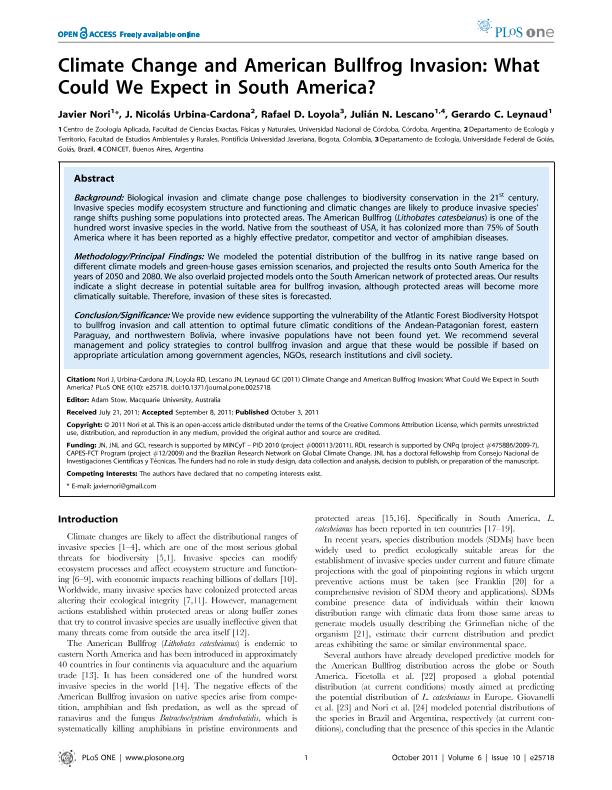Mostrar el registro sencillo del ítem
dc.contributor.author
Nori, Javier

dc.contributor.author
Urbina Cardona, Nicolás
dc.contributor.author
Loyola, Rafael

dc.contributor.author
Lescano, Julián Norberto

dc.contributor.author
Leynaud, Gerardo Cristhian

dc.date.available
2024-03-14T11:40:06Z
dc.date.issued
2011-10
dc.identifier.citation
Nori, Javier; Urbina Cardona, Nicolás; Loyola, Rafael; Lescano, Julián Norberto; Leynaud, Gerardo Cristhian; Climate change and American Bullfrog invasion: What could we expect in South America?; Public Library of Science; Plos One; 6; 10; 10-2011; 1-8
dc.identifier.issn
1932-6203
dc.identifier.uri
http://hdl.handle.net/11336/230494
dc.description.abstract
Background: Biological invasion and climate change pose challenges to biodiversity conservation in the 21century. Invasive species modify ecosystem structure and functioning and climatic changes are likely to produce invasive species? range shifts pushing some populations into protected areas. The American Bullfrog ( Lithobates catesbeianus ) is one of the hundred worst invasive species in the world. Native from the southeast of USA, it has colonized more than 75% of South America where it has been reported as a highly effective predator, competitor and vector of amphibian diseases.Methodology/Principal Findings: We modeled the potential distribution of the bullfrog in its native range based on different climate models and green-house gases emission scenarios, and projected the results onto South America for the years of 2050 and 2080. We also overlaid projected models onto the South American network of protected areas. Our results indicate a slight decrease in potential suitable area for bullfrog invasion, although protected areas will become more climatically suitable. Therefore, invasion of these sites is forecasted. Conclusion/Significance: We provide new evidence supporting the vulnerability of the Atlantic Forest Biodiversity Hotspot to bullfrog invasion and call attention to optimal future climatic conditions of the Andean-Patagonian forest, eastern Paraguay, and northwestern Bolivia, where invasive populations have not been found yet. We recommend several management and policy strategies to control bullfrog invasion and argue that these would be possible if based on appropriate articulation among government agencies, NGOs, research institutions and civil society.
dc.format
application/pdf
dc.language.iso
eng
dc.publisher
Public Library of Science

dc.rights
info:eu-repo/semantics/openAccess
dc.rights.uri
https://creativecommons.org/licenses/by-nc-sa/2.5/ar/
dc.subject
South America
dc.subject
Biological Invasion
dc.subject
Lithobates catesbeianus
dc.subject
Climate Change
dc.subject
Lithobates catesbeianus
dc.subject.classification
Conservación de la Biodiversidad

dc.subject.classification
Ciencias Biológicas

dc.subject.classification
CIENCIAS NATURALES Y EXACTAS

dc.title
Climate change and American Bullfrog invasion: What could we expect in South America?
dc.type
info:eu-repo/semantics/article
dc.type
info:ar-repo/semantics/artículo
dc.type
info:eu-repo/semantics/publishedVersion
dc.date.updated
2024-03-05T13:19:03Z
dc.journal.volume
6
dc.journal.number
10
dc.journal.pagination
1-8
dc.journal.pais
Reino Unido

dc.journal.ciudad
Cambridge
dc.description.fil
Fil: Nori, Javier. Consejo Nacional de Investigaciones Científicas y Técnicas. Centro Científico Tecnológico Conicet - Córdoba. Instituto de Diversidad y Ecología Animal. Universidad Nacional de Córdoba. Facultad de Ciencias Exactas Físicas y Naturales. Instituto de Diversidad y Ecología Animal; Argentina. Universidad Nacional de Córdoba. Facultad de Ciencias Exactas Físicas y Naturales. Centro de Zoología Aplicada; Argentina
dc.description.fil
Fil: Urbina Cardona, Nicolás. Pontificia Universidad Javeriana; Colombia
dc.description.fil
Fil: Loyola, Rafael. Universidade Federal de Goiás; Brasil
dc.description.fil
Fil: Lescano, Julián Norberto. Consejo Nacional de Investigaciones Científicas y Técnicas. Centro Científico Tecnológico Conicet - Córdoba. Instituto de Diversidad y Ecología Animal. Universidad Nacional de Córdoba. Facultad de Ciencias Exactas Físicas y Naturales. Instituto de Diversidad y Ecología Animal; Argentina. Universidad Nacional de Córdoba. Facultad de Ciencias Exactas Físicas y Naturales. Centro de Zoología Aplicada; Argentina
dc.description.fil
Fil: Leynaud, Gerardo Cristhian. Universidad Nacional de Córdoba. Facultad de Ciencias Exactas Físicas y Naturales. Centro de Zoología Aplicada; Argentina. Consejo Nacional de Investigaciones Científicas y Técnicas. Centro Científico Tecnológico Conicet - Córdoba. Instituto de Diversidad y Ecología Animal. Universidad Nacional de Córdoba. Facultad de Ciencias Exactas Físicas y Naturales. Instituto de Diversidad y Ecología Animal; Argentina
dc.journal.title
Plos One

dc.relation.alternativeid
info:eu-repo/semantics/altIdentifier/url/https://journals.plos.org/plosone/article?id=10.1371/journal.pone.0025718
dc.relation.alternativeid
info:eu-repo/semantics/altIdentifier/doi/https://doi.org/10.1371/journal.pone.0025718
Archivos asociados
